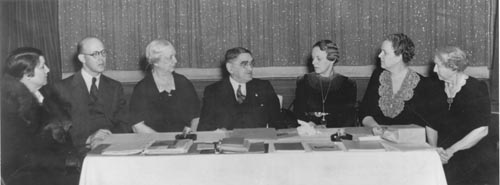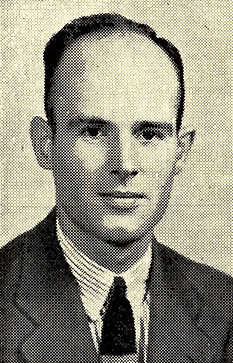Cannon, Ruth Louise Coltrane
15 Oct. 1891–22 Dec. 1965
See also: Cannon Award.
Ruth Louise Coltrane Cannon, civic leader, preservationist, historian, and benefactor, was born in Cabarrus County, daughter of Mariam Winslow and Daniel Branson Coltrane. Her father was the founder of North Carolina's oldest national bank, Concord National Bank, and was a Civil War veteran. She was the wife of Charles A. Cannon, who was variously president and chairman of the board of Cannon Mills Company for fifty years. His father, James W. Cannon, founded the company in 1887.
 Miss Coltrane was educated in the Concord public schools and was graduated summa cum laude from Greensboro College in 1911. An energetic and intelligent person, she never lost her love of learning. In 1965, Catawba College awarded her an honorary Litt.D. degree in recognition of her contributions to the cultural, educational, and religious life of the Concord-Kannapolis community and the state.
Miss Coltrane was educated in the Concord public schools and was graduated summa cum laude from Greensboro College in 1911. An energetic and intelligent person, she never lost her love of learning. In 1965, Catawba College awarded her an honorary Litt.D. degree in recognition of her contributions to the cultural, educational, and religious life of the Concord-Kannapolis community and the state.
A history major in college, Mrs. Cannon kept this interest throughout her life. She was recognized as an authority on Cabarrus County history, especially the colonial and Confederate periods. She was chairman of the Cabarrus Committee of the National Society of the Colonial Dames of America and a member of the Daughters of the American Revolution, Daughters of the American Colonists, North Carolina Society of Descendents of the Pilgrims, Daughters of 1812, Daughters of Colonial Wars, and Colonial Dames Club of Washington, D.C. She served as chairman of the Confederate Museum in Memorial Hall in Concord. The Coltrane-Harris chapter of the United Daughters of the Confederacy in Concord was named in honor of her father, and Mrs. Cannon was honorary president. She also served as president of the Dodson Ramseur chapter of the United Daughters of the Confederacy and was honorary president of the Ruth Coltrane Cannon chapter of the Children of Confederacy at Kannapolis. She played an active role for many years in the celebration of Confederate Memorial Day in Concord and especially enjoyed entertaining the hundreds of participating schoolchildren at her home, following ceremonies at the county's Confederate monument.
Mrs. Cannon worked throughout her life to bring an appreciation and better understanding of its heritage to North Carolina. She was the first woman to head the Roanoke Island Historical Association, which produces the Lost Colony historical drama. She also was interested in Horn in the West, an outdoor drama presented in Boone; an active supporter, she attended regularly. She took primary responsibility for the production of a volume listing all Cabarrus soldiers who participated in wars—A History of Cabarrus County in the Wars, privately published in memory of her father.
Active in restoration projects throughout the state, Mrs. Cannon collected data for a book, Old Homes and Gardens of North Carolina, which was published under her direction as chairman of the restoration committee of the North Carolina Garden Club. She also served on the steering committee of the North Carolina Society for the Preservation of Antiquities. She was president of this organization from its beginning and was named honorary life president. Annual teas honoring members and officers of this society were given by Mr. and Mrs. Cannon in their Blowing Rock home. She established, through this society, the Charles A. Cannon award, which has been given each year since 1948 for distinguished work in historical research, preservation, and restoration. An original member of the Tryon Palace Commission, Mrs. Cannon served the group for twenty years. She was also instrumental in such major restoration projects as Tryon Palace and Bath, as well as the creation of the Elizabethan garden at Manteo.
A skilled gardener, Mrs. Cannon promoted garden clubs and served for ten years as chairman of the life membership committee of the Garden Clubs of North Carolina. She was a member of the American Rose Society and the American Horticultural Society and organized the Concord Garden Club. Her love for gardens and restoration was exemplified in her work at her country home, For Pity's Sake, located on Lake Kannapolis. She devoted years to this home, which became famous for its antiques and gardens and attracted many visitors. Easter sunrise services for the community were a tradition in Kannapolis for many years.
Active in all phases of civic life, Mrs. Cannon helped start the Cabarrus Red Cross during World War II and served on the Concord School Board. She shared her husband's lifelong interest in Cabarrus Memorial Hospital. She helped organize the women's auxiliary there and compiled the group's cookbook. She and her husband also contributed to the Charles A. Cannon, Jr., Memorial Hospital at Banner Elk, named in memory of their son, who lost his life as an army pilot in World War II. The addition of the women's department of the Kannapolis YMCA in the 1930s was brought about by Mrs. Cannon. She contributed to the Church of God's Children's Home in Cabarrus County and the Grandfather Home for Children in Banner Elk. A dormitory at Wingate College was named in her honor to recognize her interest and contributions, and she also helped Lees-McRae College.
 Mrs. Cannon inspired the rebuilding of Kannapolis's downtown business section. Harmonious colonial Williamsburg architecture was introduced in building programs of the early 1940s.
Mrs. Cannon inspired the rebuilding of Kannapolis's downtown business section. Harmonious colonial Williamsburg architecture was introduced in building programs of the early 1940s.
Music was an important part of Mrs. Cannon's life. She was instrumental in establishing the first music department in the Kannapolis schools, and the music building at A. L. Brown High School was dedicated to her memory in 1969. In the same year, the Cannon Music Camp was established at Appalachian State University, Boone, in her memory. There high school students receive four weeks of intensive training in music theory with individual lessons in their major instrument and group experience in ensemble, chorus, orchestra, and band. The university also named a residence hall in honor of Charles A. and Ruth Coltrane Cannon.
Mrs. Cannon was a member of the Central United Methodist Church until her marriage, when she joined the First Presbyterian Church in Concord. Mrs. and Mrs. Cannon gave a memorial organ to Central United Methodist Church in honor of her mother, Mrs. D. B. Coltrane. The Presbyterian church also benefited from their contributions, and Mrs. Cannon was active in several church departments.
Other organizations to which she belonged included the American War Mothers, Southern Historical Society, Mint Museum in Charlotte, Folklore Society, North Carolina Archaeology Society, North Carolina Symphony, and the study club affiliated with the North Carolina Federation of Women's Clubs. She was a director of the North Carolina State Art Society.
Ruth Coltrane was married 5 June 1912 to Charles A. Cannon. They were the parents of four children: William Coltrane of Concord; Mariam (Mrs. Robert) Hayes of Concord; Mary Ruth (Mrs. Richard) Spencer of Carmel, Calif.; and Charles A., Jr., who was killed in World War II.
Mrs. Cannon died at her home in Concord and was buried in Oakwood Cemetery there.
References:
Charlotte News, 1 June 1965.
Kannapolis Daily Independent, 23 Dec. 1965.
History of North Carolina, vol. 3 (1956).
Raleigh News and Observer, 30 Mar. 1958, 23 Dec. 1965.
Raleigh Times, 2 Dec. 1965.
personal papers in possession of the Cannon family, Concord.
Who's Who in the South and Southwest (1961).
Additional Resources:
Dearmon, Norris. "Ruth Cannon left her own mark on Kannapolis." Salisbury Post. September 7, 2009. http://m.salisburypost.com/2009/12/01/dearmon-column-ruth-cannon-left-he...
Mrs. Charles A. Cannon Papers, 1934-1953 (collection no. 02551). The Southern Historical Collection. Louis Round Wilson Special Collections Library. University of North Carolina at Chapel Hill. http://www.lib.unc.edu/mss/inv/c/Cannon,Charles_A.,Mrs.html (accessed June 26, 2013).
Image Credits:
"SOCIETY FOR THE PRESERVATION OF ANTIQUITIES." Photograph. December 1939. North Carolina Office of Archives & History. http://www.history.ncdcr.gov/centennial/photo-gallery/images_30-39.htm (accessed June 26, 2013).
"Lieutenant Charles A. Cannon, Jr." The Uplift 34, no. 12 (March 23, 1946). 3-4. https://archive.org/stream/upliftserial34151ston#page/n359/mode/2up/ (accessed June 26, 2013).
1 January 1979 | Rankin, Edward L., Jr.